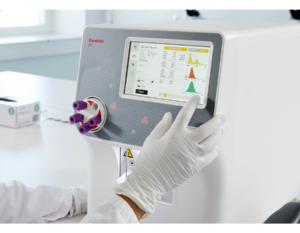Both the innate and adaptive immune responses play a key role in fighting COVID-19 infection, although at different stages of the disease process. While the innate immune cells, like the granulocytes, help limit virus replication and promote its clearance, the T and B lymphocytes of the adaptive immune response help control the infection (1).
Although most infections are mild, some patients develop systemic inflammation and acute respiratory distress syndrome (ARDS) (2). Study from National Academy of Sciences of Ukraine in Kyiv, Ukraine shows the activation of an adaptive immune response against the inflammation progressing in the lungs (3).
Dynamic changes in peripheral blood cells in patients with severe COVID-19 disease
Years after the initial outbreak, COVID-19 continues to be persistent with new variants emerging on a regular basis (4). An extensive number of studies have been conducted to understands the biology of the virus itself as well as the host’s immune response to an infection.
One feature of COVID-19 in the release of pro-inflammatory cytokines by various immune and non-immune effector cells (5). Leukocytes activated within an excessive systemic inflammatory response contribute to the pathophysiology of ARDS.
In a recent study, Bukreieva and coworkers at the National Academy of Sciences of Ukraine used a Swelab Alfa-series hematology system to investigate the dynamic changes in peripheral blood cells in patients with severe COVID-19 disease (3). They found increased levels of white blood cells and granulocytes on day 7 after admission, while steadily decreased by day 28. Furthermore, CRP levels were found to be positively correlated with the granulocyte count and negatively correlated with the lymphocyte count in these patients.

Swelab Alfa Plus hematology analyzer
For further understanding of the immune response, Bukreieva and coworkers monitored changes in the levels of immune cells, cytokines, and selected miRNAs in these patients (3). In the beginning of admission, patients were found to be in an immunodeficiency state with observed lymphopenia and leucopenia, developing the “cytokine storm” syndrome. At Day 14 after admission, an increase in T cells and dendritic cells was observed, indicate a formation of an adaptive immunity over the period of hospitalization.
Learn more
Read more about the use of the results from a complete blood count (CBC) in investigations of infectious diseases.
References
- Shen et al. Innate and adaptive immunity to SARS-CoV-2 and predisposing factors. Immunol https://doi.org/10.3389/fimmu.2023.1159326 (2023).
- Diamond and Kanneganti. Innate immunity: the first line of defense against SARS-CoV-2. Nature Immunology 23, 165–176 (2022).
- Bukreieva et al. Dynamic changes in radiological parameters, immune cells, selected miRNAs, and cytokine levels in peripheral blood of patients with severe COVID‑ Biomedical Reports 18 DOI:10.3892/br.2023.1615 (2023).
- Markov et al. The evolution of SARS-CoV-2. Nature Reviews Microbiology 21, 361–379 (2023).
- Darif et al. The pro-inflammatory cytokines in COVID-19 pathogenesis: What goes wrong? Microbial Pathogenesis https://doi.org/10.1016/j.micpath.2021.104799 (2021).



